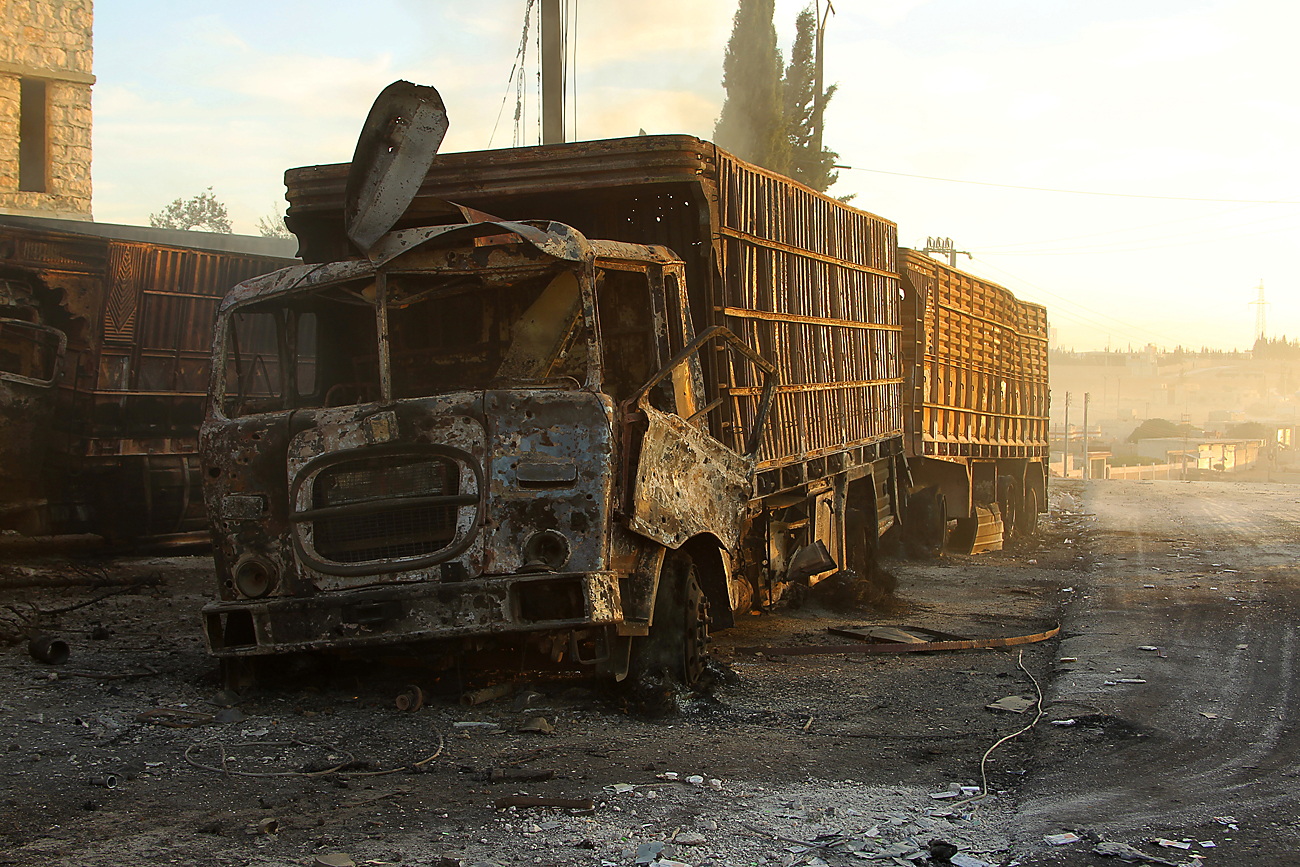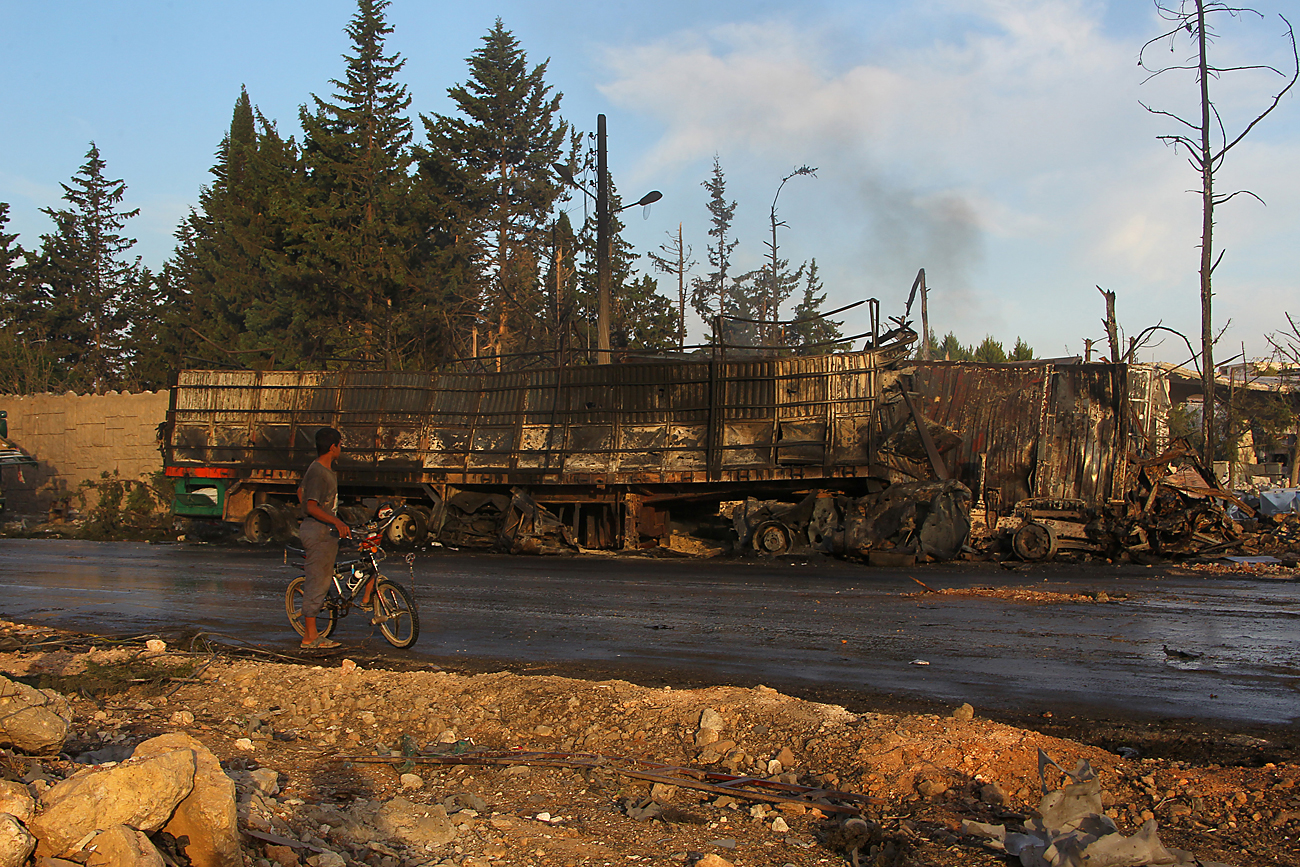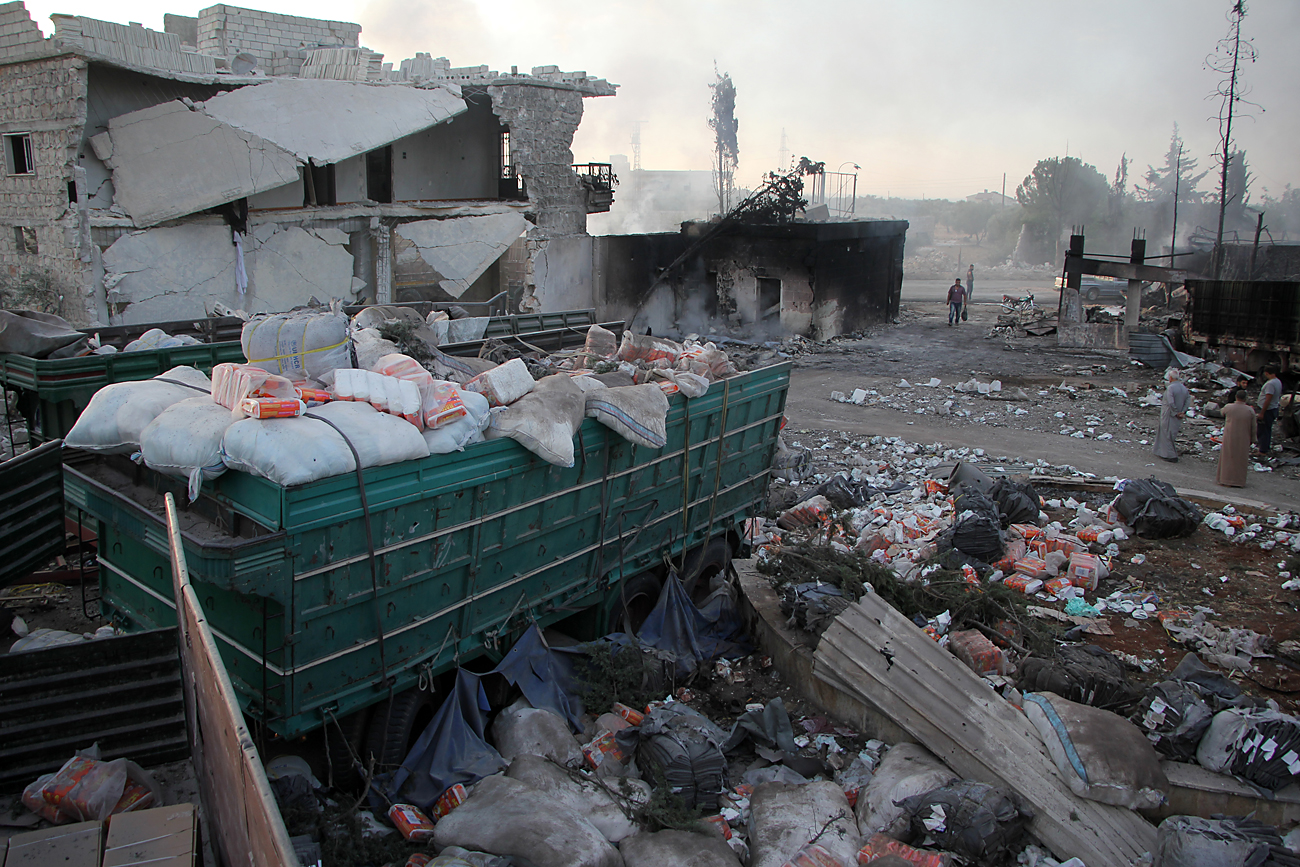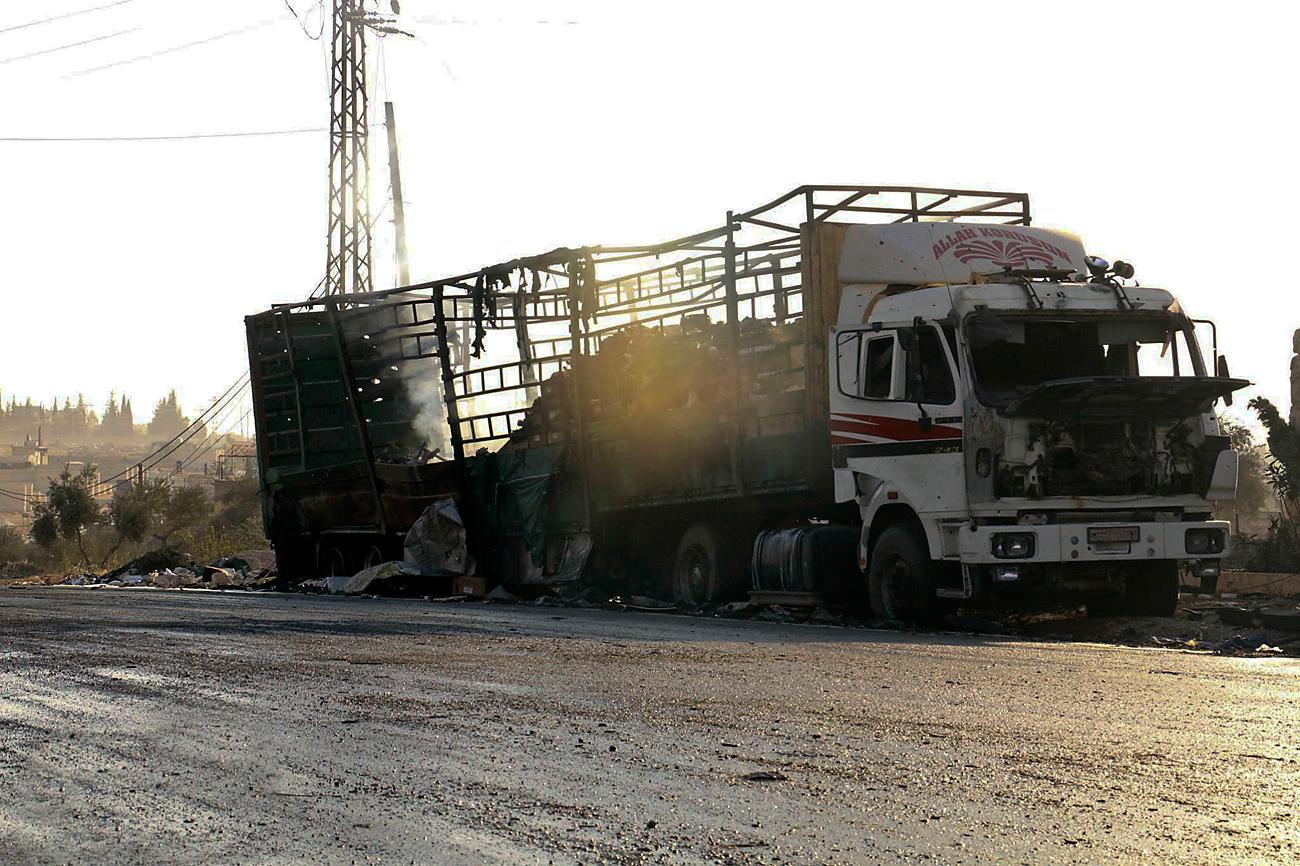Did Russian planes bomb the UN humanitarian convoy in Syria?

Damaged aid trucks are pictured after an airstrike on the rebel held Urm al-Kubra town, western Aleppo city, Syria, on Sept. 20, 2016.
ReutersWhat happened?
On the evening of Sept. 19 a UN humanitarian convoy was shelled northwest of the Syrian city of Aleppo. As a result 20 people died and 18 out of the 31 trucks carrying provisions and medication for the residents of a rebel-held part of the occupied city were destroyed.
 A boy inspects a damaged aid truck after an airstrike on the rebel held Urm al-Kubra town, western Aleppo city, Syria on Sept. 20, 2016. Source: Reuters
A boy inspects a damaged aid truck after an airstrike on the rebel held Urm al-Kubra town, western Aleppo city, Syria on Sept. 20, 2016. Source: Reuters
Did Russian planes bomb the convoy?
It is not known for certain. The American military says that only Russian or Syrian army planes could have attacked the convoy. Russian officials deny these accusations.
What are Washington’s arguments?
The convoy was bombed by two Russian Su-24 bombers, U.S. government sources told Reuters, citing information provided by American reconnaissance. However, neither the sources' names nor the proof itself have been revealed.
"In any case we hold the Russian government responsible for the airstrike in this area, given their adherence to the ceasefire," Reuters quotes Deputy Advisor on National Security to the U.S. President Ben Rhodes as saying.
U.S. State Department Spokesman John Kirby said that Washington was "outraged" by the incident.
The United States is outraged by reports that a humanitarian aid convoy was bombed near #Aleppo today. pic.twitter.com/yCurP3rwUV
— John Kirby (@statedeptspox) September 20, 2016
"The destination of this convoy was known to the Syrian regime and the Russian Federation and yet these aid workers were killed in their attempt to provide relief to the Syrian people," wrote Kirby, adding that the U.S. will "reassess the future prospects for cooperation with Russia."
 Aid is seen strewn across the floor in the town of Orum al-Kubra on the western outskirts of the northern Syrian city of Aleppo on Sept. 20, 2016, the morning after a convoy delivering aid was hit by a deadly air strike. The UN said at least 18 trucks in the 31-vehicle convoy were destroyed en route to deliver humanitarian assistance to the hard-to-reach town. Source: AFP/East News
Aid is seen strewn across the floor in the town of Orum al-Kubra on the western outskirts of the northern Syrian city of Aleppo on Sept. 20, 2016, the morning after a convoy delivering aid was hit by a deadly air strike. The UN said at least 18 trucks in the 31-vehicle convoy were destroyed en route to deliver humanitarian assistance to the hard-to-reach town. Source: AFP/East News
What are the Russians saying?
The Russian Defense Ministry refuted the version of the UN humanitarian convoy being destroyed by an airstrike. The ministry claimed it had not discovered any craters that would have been created by bombs near the truck, and said the vehicles' chassis remained intact and undamaged by the explosion.
According to the ministry, the trucks "strangely" caught fire at the same time that Al Nusra Front militants began their advance on Aleppo from the same area.
Video footage taken by a Russian Defense Ministry drone shows a pickup with a large-caliber mortar accompanying the convoy as it passes through rebel territory.
Video footage taken by a Russian Defense Ministry drone. Source: Russian Defense Ministry/Youtube
"And the most important thing is: Where did the mortar disappear to near the convoy's destination point and at whom did it fire as the convoy was standing and unloading?" asked Russian Defense Ministry spokesman Major General Igor Konashenkov during a press briefing on Sept. 20.
Russian Foreign Minister Sergei Lavrov said that it could not have been the Syrian air force that attacked the UN mission near Aleppo since it does not conduct flights in the dark.
Later, on Sept. 21, Konashenkov claimed that the Russian military had spotted a U.S. unmanned aircraft in the area at the time of the incident.
"In the evening of September 19 an attack drone of the international coalition was registered in that area at an altitude of 3,600 meters,” he said, adding that the drone had taken off from Turkey’s Incirlik air base.
Who do the Russians say killed the UN humanitarian workers?
Moscow insists that the attack on the convoy was carried out by Al Nusra Front militants opposed to Syrian President Bashar al-Assad.
"The neighborhood in which the UN humanitarian convoy was shelled is located 20 km northwest of the city, controlled by Al Nusra Front militants," said military expert and editor-in-chief of the Arsenal Otechestva (“Arsenal of the Fatherland”) magazine Viktor Murakhovsky.
Murakhovsky argues that a specialist needs to be sent to the site of the incident in order to provide a precise "diagnosis." The specialist would base their decision on the epicenter of the explosions, the shape of the fragments and where they landed (their flight and the flight direction of the striking parts of the charge), the type of ammunition and the area of the strike.
 The image provided by the Syrian anti-government group Aleppo 24 news shows a vest of the Syrian Arab Red Crescent hanging on a damaged vehicle, in Aleppo, Syria. Source: AP
The image provided by the Syrian anti-government group Aleppo 24 news shows a vest of the Syrian Arab Red Crescent hanging on a damaged vehicle, in Aleppo, Syria. Source: AP
Murakhovsky added that the trucks could have been destroyed by reactive shells with a warhead resembling a gas bottle and filled with nails, nuts and bolts, which are commonly used in Syria.
"The shell is launched from an ordinary tripod or pipe that is sawed and welded in a simple factory," he explained.
What will be the outcome of the attack?
For now we must forget about the peaceful regulation of the situation in Syria for a while, says editor-in-chief of the National Defense magazine Igor Korotchenko. The US Air Force's shelling of the Syrian Army in Deir el-Zour and the attack on the UN convoy near Aleppo have forced the world into the dimension of a new information war between Moscow and Washington.
"We are moving into a new cycle in the Syrian crisis, which threatens to become a proxy war between Russia and the U.S.," said Fyodor Lukyanov, editor-in-chief of the Russia in Global Politics journal.
In his view, Moscow and Washington will oppose each other through their sponsored parties in Syria.
Read more: Russia insists on thorough investigation into aid convoy attack near Aleppo>>>
Subscribe to get the hand picked best stories every week
All rights reserved by Rossiyskaya Gazeta.
Subscribe
to our newsletter!
Get the week's best stories straight to your inbox